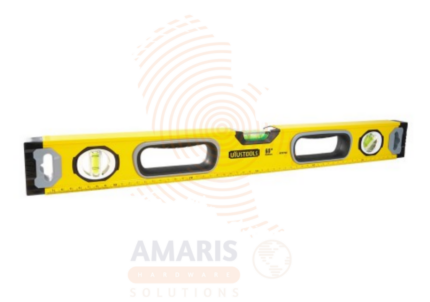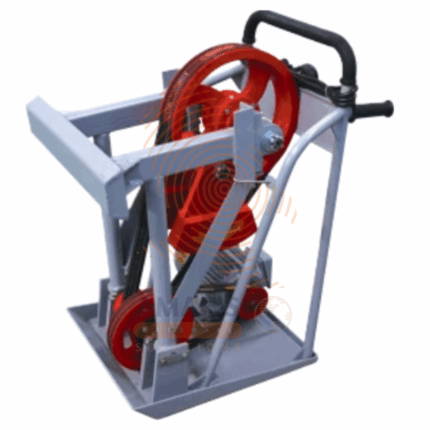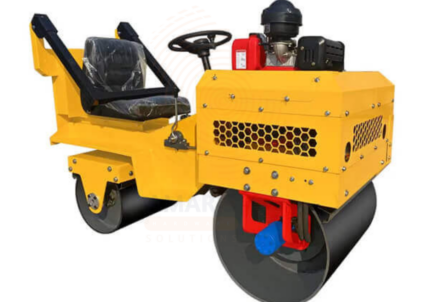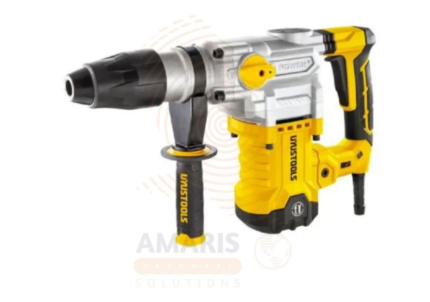Compactor
WhatsApp Order
A compactor is a heavy-duty construction machine designed to compress soil, gravel, asphalt, or other materials to increase their density and stability. This equipment is essential for preparing surfaces for roads, foundations, and other infrastructure projects. Compactors come in various types, including plate compactors, roller compactors, and rammer compactors, each suited to specific compaction tasks. Their ability to enhance material stability reduces settling and improves structural integrity, making them indispensable in construction and landscaping.
Description
Table of Contents
ToggleCompactor
Uses
-
Soil Compaction
-
Used to compact soil in preparation for foundations, landscaping, and roadworks to prevent settling and increase load-bearing capacity.
-
Enhances the density of different soil types like clay, sand, and silt to improve structural support.
-
-
Asphalt Compaction
-
Essential for compressing asphalt layers during road construction and repair, ensuring smooth, durable surfaces.
-
Helps eliminate air pockets and creates a strong, even surface that resists cracking and potholes.
-
-
Gravel and Aggregate Compaction
-
Compacts gravel and crushed stone bases for driveways, walkways, and foundations to provide a stable base.
-
Increases bearing capacity and prevents material displacement.
-
-
Trench and Pipeline Work
-
Used to compact backfill around trenches and pipelines, preventing ground shifting and damage.
-
Helps avoid pipe misalignment and soil erosion around underground installations.
-
-
Landscaping Projects
-
Helps compact soil in garden beds, pathways, patios, and retaining wall foundations to improve stability and prevent erosion.
-
Facilitates proper leveling and preparation of land for planting or construction.
-
-
Foundation Preparation
-
Ensures a solid base for buildings, walls, and other structures by compacting underlying materials.
-
Reduces risk of foundation settlement and structural failure.
-
-
Pavement Maintenance
-
Used in maintenance and repair projects to recompact surfaces and extend pavement life.
-
Assists in leveling and strengthening worn or damaged surfaces.
-
-
Earthworks and Infrastructure
-
Facilitates compaction of embankments, dams, landfills, and road sub-bases for structural strength and environmental safety.
-
Helps prevent soil liquefaction in seismic areas.
-
-
Waste Management
-
Compactors are used to compress waste materials to reduce volume in landfills and recycling operations, improving space efficiency.
-
SAFETY HANDLING PRECAUTIONS
Safety Precautions
-
Wear Protective Gear
-
Use safety glasses or goggles to protect eyes from flying debris and dust.
-
Wear ear protection such as earmuffs or earplugs to prevent hearing damage from prolonged exposure to loud noise.
-
Use vibration-resistant gloves to protect hands from vibration-related injuries.
-
Wear steel-toed boots to protect feet from heavy objects and possible crushing.
-
Wear long-sleeved clothing and durable workwear to protect the body from cuts, abrasions, and heat.
-
-
Inspect Equipment
-
Perform a thorough inspection of the compactor before use to check for leaks, cracks, loose bolts, or other damage.
-
Ensure all safety guards and emergency stop mechanisms are present and operational.
-
Confirm fuel or electrical components are intact and safe to operate.
-
-
Safe Operation Practices
-
Operate the compactor only on stable, level surfaces to avoid tipping or loss of control.
-
Keep a firm two-handed grip on the machine’s handles to maintain control, especially on uneven terrain.
-
Avoid sudden movements or jerky operations that could lead to injury or equipment damage.
-
Never operate the compactor near edges, trenches, or slopes without proper barriers or supports.
-
-
Maintain a Safe Work Area
-
Clear the area of unnecessary personnel, obstacles, and loose debris before operation.
-
Ensure good lighting and visibility, especially when working in confined spaces or low-light conditions.
-
Set up warning signs or barriers to keep bystanders at a safe distance.
-
-
Manage Vibration Exposure
-
Limit continuous use time to reduce the risk of hand-arm vibration syndrome (HAVS).
-
Take regular breaks and use vibration-dampening gloves if available.
-
-
Fuel and Electrical Safety
-
Refuel gasoline or diesel-powered compactors only when the engine is off and cooled down, away from ignition sources.
-
Store fuel safely in approved containers and avoid spills.
-
For electric compactors, check cables for damage and use a ground fault circuit interrupter (GFCI) to prevent electric shock.
-
-
Emergency Preparedness
-
Familiarize yourself with emergency shutdown procedures and controls.
-
Keep a fire extinguisher nearby when operating fuel-powered compactors.
-
Know the location of first aid kits and emergency exits on the worksite.
-
-
Training and Manual
-
Read and understand the manufacturer’s manual and safety instructions before operation.
-
Only trained and authorized personnel should operate the compactor.
-
Stay updated on safety protocols and proper machine handling techniques.
-
Related products
Box Beam Spirit Level Pro – Magnetic
A Box Beam Spirit Level Pro - Magnetic is a precision hand tool used for measuring the levelness and plumbness of surfaces. Its rigid box-shaped aluminum body provides durability and stability during use. The tool contains liquid-filled vials with air bubbles to indicate horizontal, vertical, and 45-degree angles. The magnetic base allows for secure attachment to metal surfaces, enabling hands-free operation. This level is essential in construction, carpentry, metalworking, and any tasks requiring accurate surface alignment.
Frog Tamping Rammer
A Frog Tamping Rammer is a compact, high-impact compaction machine used in construction for compacting soil, gravel, and sand in confined or hard-to-reach areas. Unlike larger plate or roller compactors, this rammer delivers a powerful vertical force through a narrow, foot-like base (hence the name “frog”) to compact cohesive and granular soils. Commonly powered by gasoline or diesel engines, it is ideal for trench work, pipeline backfilling, foundations, road repairs, and other applications where precision and deep compaction are essential. Known for its portability and high compaction force, the frog rammer is indispensable in urban construction, civil engineering, and landscaping projects.
Plastering Trowel with Teeth
A plastering trowel with teeth, commonly known as a "notched trowel" or "toothed trowel," is a specialized hand tool used in construction and masonry for applying adhesive or mortar to surfaces, such as when installing tiles or laying flooring. It is characterized by a flat metal blade with evenly spaced teeth or notches along one or more edges. The teeth help create uniform ridges or grooves in the applied material, ensuring proper adhesion and facilitating an even distribution of the substance onto the substrate. This type of trowel is particularly useful for tasks that require consistent coverage and bonding, such as in the installation of tiles or other similar construction applications.
Road Roller
A Road Roller is a heavy-duty compaction machine used in construction to compress soil, asphalt, gravel, and other materials to improve surface stability and load-bearing capacity. It uses large cylindrical drums—sometimes vibratory or pneumatic—to eliminate air gaps and provide a smooth, dense surface. Road rollers are essential in road building, foundations, embankments, and landfills for long-lasting structural integrity.
Rotary Hammer Variable Speed
A Rotary Hammer Variable Speed refers to a power tool designed for drilling into tough materials like concrete, masonry, or stone. The term "variable speed" indicates that the tool allows the user to control the speed of the rotary motion, providing flexibility to match the drilling application and material hardness. The "1600 watts" specification denotes the power of the tool's motor, indicating its capability to deliver a higher level of energy for efficient drilling through challenging surfaces. Overall, a rotary hammer with these specifications is a robust and versatile tool suitable for demanding construction and renovation tasks.
Tile Cutter
A tile cutter is a manual or powered tool specifically designed for cutting ceramic, porcelain, or other types of tiles. It typically consists of a sharp cutting wheel or blade that is guided along a straight edge to score the tile's surface. After scoring, the tile is then snapped or separated along the scored line, resulting in a clean and precise cut. Tile cutters are widely used in construction, home improvement, and tiling projects to achieve accurate and customized tile sizes for various installations.
Vibrating Spear
A Vibrating Spear is a highly specialized construction tool designed for deep and precise soil compaction in confined or hard-to-reach spaces. The device features a slender, spear-shaped tip that penetrates compacted soil layers and granular materials. Utilizing powerful vibration technology, it breaks down dense soil structures and consolidates backfill by transmitting high-frequency oscillations deep into the ground. Typically powered by hydraulic or pneumatic systems, vibrating spears are essential in projects where traditional compaction equipment, such as rammers or rollers, cannot be used due to spatial limitations. By improving soil density and eliminating voids, the vibrating spear significantly enhances load-bearing capacity and prevents soil settlement, making it a crucial tool for trench work, pipeline bedding, foundation preparation, landscaping, and utility installations. The hot-spot of this technology lies in its ability to deliver thorough compaction in narrow trenches and around sensitive underground installations without damaging existing structures.
Winch
A winch is a mechanical device used to pull in, let out, or adjust the tension of a rope, cable, or chain. It consists of a spool (or drum) operated manually or powered by electricity, hydraulics, or a combustion engine. Winches are commonly used in construction, vehicle recovery, marine applications, off-road towing, and industrial lifting. Their ability to exert controlled pulling force makes them essential in material handling and rigging operations where moving heavy objects with precision is required.


 Acrylic Sealants
Acrylic Sealants Construction Adhesives
Construction Adhesives Double-Sided Tape
Double-Sided Tape Duct Tape
Duct Tape Electrical Tape
Electrical Tape Epoxy & Resins
Epoxy & Resins Masking Tape
Masking Tape
 Automotive Wrenches & Socket Sets
Automotive Wrenches & Socket Sets Battery Chargers & Jump Starters
Battery Chargers & Jump Starters Car Jacks & Stands
Car Jacks & Stands Car Wash & Detailing Products
Car Wash & Detailing Products Diagnostic Tools
Diagnostic Tools Tire Inflators
Tire Inflators Vehicle Lighting
Vehicle Lighting Oil & Lubricants
Oil & Lubricants
 Adhesives & Sealants
Adhesives & Sealants Bricks & Blocks
Bricks & Blocks Cement & Concrete
Cement & Concrete Drywall & Plaster
Drywall & Plaster Flooring (Tiles, Wood, Laminate)
Flooring (Tiles, Wood, Laminate) Lumber & Plywood
Lumber & Plywood Paints, Primers & Coatings
Paints, Primers & Coatings Insulation Materials
Insulation Materials Roofing Materials
Roofing Materials
 Circuit Breakers
Circuit Breakers Electrical Cables & Wires
Electrical Cables & Wires Switches & Sockets
Switches & Sockets Fuses & Relays
Fuses & Relays Connectors & Terminals
Connectors & Terminals Electrical Boxes & Panels
Electrical Boxes & Panels Conduit & Fittings
Conduit & Fittings Lighting Fixtures & Bulbs
Lighting Fixtures & Bulbs Extension Cords & Power Strips
Extension Cords & Power Strips
 Anchors
Anchors Bolts
Bolts Clips & Clamps
Clips & Clamps Screws
Screws Nuts
Nuts Washers
Washers Rivets
Rivets Nails
Nails Threaded Rods
Threaded Rods
 Hammers
Hammers Measuring Tools (Tapes, Levels, Calipers)
Measuring Tools (Tapes, Levels, Calipers) Screwdrivers
Screwdrivers Pliers & Cutters
Pliers & Cutters Saws & Blades
Saws & Blades Chisels & Punches
Chisels & Punches Allen Keys & Hex Keys
Allen Keys & Hex Keys Ratchets & Socket Sets
Ratchets & Socket Sets Wrenches & Spanners
Wrenches & Spanners
 Power Tool Accessories (Blades, Bits, Discs)
Power Tool Accessories (Blades, Bits, Discs) Rotary Tools
Rotary Tools Saws (Circular, Jigsaw, Reciprocating)
Saws (Circular, Jigsaw, Reciprocating) Drills & Drivers
Drills & Drivers Grinders & Sanders
Grinders & Sanders Heat Guns
Heat Guns Nail Guns
Nail Guns Impact Wrenches
Impact Wrenches Batteries & Chargers
Batteries & Chargers
 Pipes & Fittings (PVC, Copper, PEX)
Pipes & Fittings (PVC, Copper, PEX) Plumbing Tools
Plumbing Tools Pumps & Motors
Pumps & Motors Sealants & Adhesives for Plumbing
Sealants & Adhesives for Plumbing Valves & Taps
Valves & Taps Water Heaters
Water Heaters Drainage Systems
Drainage Systems Faucets & Fixtures
Faucets & Fixtures Hoses & Tubing
Hoses & Tubing
 Hinges & Latches
Hinges & Latches Hooks & Brackets
Hooks & Brackets Window Hardware
Window Hardware Chains & Cables
Chains & Cables Casters & Wheels
Casters & Wheels Shelving & Storage Systems
Shelving & Storage Systems Door Handles & Locks
Door Handles & Locks Drawer Slides & Cabinet Hardware
Drawer Slides & Cabinet Hardware
 Personal Protective Equipment (PPE)
Personal Protective Equipment (PPE) Respirators & Masks
Respirators & Masks Safety Glasses
Safety Glasses Safes
Safes Security Cameras
Security Cameras Gloves
Gloves Helmets
Helmets Ear Protection
Ear Protection Fire Safety Equipment
Fire Safety Equipment Locks & Padlocks
Locks & Padlocks Motion Sensors & Alarms
Motion Sensors & Alarms
 Garden Fencing
Garden Fencing Garden Furniture Hardware
Garden Furniture Hardware Lawn Mowers
Lawn Mowers Trimmers & Edgers
Trimmers & Edgers Shovels & Spades
Shovels & Spades Rakes & Hoes
Rakes & Hoes Pruning Shears & Loppers
Pruning Shears & Loppers Watering Systems (Hoses, Sprinklers, Nozzles)
Watering Systems (Hoses, Sprinklers, Nozzles)
 Interior Paints
Interior Paints Paint Brushes & Rollers
Paint Brushes & Rollers Paint Strippers & Thinners
Paint Strippers & Thinners Paint Trays & Accessories
Paint Trays & Accessories Exterior Paints
Exterior Paints Spray Paints
Spray Paints Primers & Undercoats
Primers & Undercoats Varnishes & Stains
Varnishes & Stains
 Gaskets & Seals
Gaskets & Seals Hydraulic Fittings
Hydraulic Fittings Industrial Fasteners
Industrial Fasteners Industrial Hoses
Industrial Hoses Lubricants & Greases
Lubricants & Greases Metal Sheets & Bars
Metal Sheets & Bars Bearings & Bushings
Bearings & Bushings Belts & Pulleys
Belts & Pulleys
 HVAC Filters
HVAC Filters Insulation for HVAC
Insulation for HVAC Air Conditioners
Air Conditioners Refrigerants
Refrigerants Ventilation Ducts & Fittings
Ventilation Ducts & Fittings Thermostats & Controllers
Thermostats & Controllers Fans & Blowers
Fans & Blowers
 Pegboards & Hooks
Pegboards & Hooks Shelving Units
Shelving Units Storage Bins & Containers
Storage Bins & Containers Toolboxes & Tool Chests
Toolboxes & Tool Chests Workbenches
Workbenches Drawer Organizers
Drawer Organizers Labeling Supplies
Labeling Supplies
 Welding Accessories (Clamps, Brushes)
Welding Accessories (Clamps, Brushes) Welding Electrodes & Rods
Welding Electrodes & Rods Welding Helmets & Gloves
Welding Helmets & Gloves Welding Machines
Welding Machines Soldering Irons & Stations
Soldering Irons & Stations Flux & Solder Wire
Flux & Solder Wire
 Generator Accessories
Generator Accessories Inverters
Inverters Portable Generators
Portable Generators Power Inverters
Power Inverters Transfer Switches
Transfer Switches Diesel & Gasoline Generators
Diesel & Gasoline Generators
 Transport Equipment: Carts, Dollies, and Hand Trucks
Transport Equipment: Carts, Dollies, and Hand Trucks Storage Solutions: Pallets, Racks, and Containers
Storage Solutions: Pallets, Racks, and Containers Lifting Equipment: Hoists, Cranes, and Jacks
Lifting Equipment: Hoists, Cranes, and Jacks Conveyors and Accessories: Belts and Rollers
Conveyors and Accessories: Belts and Rollers












